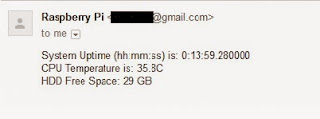If you have working DS18B20 temperature sensors configured from
here and want to receive mail when temperature is high or low next script is for you.
CODE:
#!/usr/bin/python
# -*- coding: utf-8 -*-
#
# read 1-wire sensor
# in case of value exceeding alarm limit
# send email via smtp
# 2013-06-06 V0.2 by Thomas Hoeser
# 2015-02-01 Edited by Aleksandar Stoichkov
#
import sys
import smtplib
from email.mime.multipart import MIMEMultipart
from email.mime.text import MIMEText
mail_server = 'smtp.gmail.com:587' # Mail Server
mail_account = 'sendersmail@gmail.com' # name of mail account
mail_password = 'senderspassword' # password
addr_sender = 'sendersmail@gmail.com' # sender email
addr_receiver = 'receiversmail@gmail.com' # receiver email
verbose_level = 2
debug_level = 0
error_temp = -999
# dictionary with for 1-wire sensors: [sensor name] [1-Wire device]
sensor_dict = { "IN": "28-000004d05fbe",
"OUT" : "28-000004d05fbe",
"Office" : "28-00000534eec5"
}
#-------------------------------------------------------------------------------------------
def read_sensor(Sensor):
if verbose_level > 2:
print "1++++ read_sensor()"
print "sensor:" , Sensor
if debug_level == 0:
# get 1-Wire id from dictionary
sensor_slave = str(sensor_dict.get(Sensor))
# Open 1-wire slave file
sensor_device = '/sys/bus/w1/devices/' + str(sensor_slave) + '/w1_slave'
if verbose_level > 2:
print "open: ", sensor_device
try:
file = open(sensor_device)
filecontent = file.read() # Read content from 1-wire slave file
file.close() # Close 1-wire slave file
stringvalue = filecontent.split("\n")[1].split(" ")[9] # Extract temperature string
if stringvalue[0].find("YES") > 0:
temp = error_temp
else:
temp = float(stringvalue[2:]) / 1000 # Convert temperature value
# temp=str(temp)
except IOError:
print "PANIC read_sensor - Cannot find file >" + sensor_slave + "< in /sys/bus/w1/devices/"
print "No sensor attached"
print "check with > cat /sys/devices/w1_bus_master1/w1_master_slaves"
temp=("Sensor not attached")
else:
# this is dummy function generating a random number
# ony used for testing purposes
temp = random.randrange(-10, 30, 2) + 0.3
# temp = Sensor + " " + str(temp)
return(temp) # exit function read_sensor
# --------------------------------------------------------------------------------
def send_mail(title,message):
debug_level = 0 # set to 1 to get more messages
# Create message container - the correct MIME type is multipart/alternative.
msg = MIMEMultipart('alternative')
msg['Subject'] = title
msg['From'] = addr_sender
msg['To'] = addr_receiver
# Create the body of the message (a plain-text and an HTML version).
text = message
html = """\
"""
html += message
html += """\
This is a service provided by raspberry
"""
# print html
# Record the MIME types of both parts - text/plain and text/html.
part1 = MIMEText(text, 'plain')
part2 = MIMEText(html, 'html')
# Attach parts into message container.
msg.attach(part1)
msg.attach(part2)
mailsrv = smtplib.SMTP('smtp.gmail.com' , 587)
mailsrv.starttls()
mailsrv.login("sendesrsmail@gmail.com", "senderspassword")
mailsrv.sendmail("sendersmail@gmail.com", "receiversmail@gmail.com", msg.as_string())
mailsrv.quit()
return()
try:
if debug_level > 0: print "smtplib.SMTP:", mail_server
mailsrv = smtplib.SMTP(mail_server) # Send the message via local SMTP server.
except:
print "Error: unable to send email - smtp server"
print "Server on ", mail_server, " cannot be reached or service is down"
return()
try:
if debug_level > 0: print "mailsrv.login:", mail_account, mail_password
mailsrv.login(mail_account,mail_password)
except:
print "Error: unable to send email - login failed"
print "login is not valid - check name and password:",mail_account,mail_password
return()
try:
# sendmail function takes 3 arguments: sender's address, recipient's address and message to send - here it is sent as one string.
if debug_level > 0: print "mailsrv.sendmail:", addr_sender, addr_receiver
mailsrv.sendmail(addr_sender, addr_receiver, msg.as_string())
mailsrv.quit()
print "Successfully sent email"
except:
print "Error: unable to send email - wrong address"
print "mail address for sender or receiver invalid:",addr_sender,addr_receiver
#---------------------------------------------------------------------------------------------
if __name__ == "__main__":
alarm_hi = 70.5 # upper alarm level
alarm_lo = 12.5 # lowe alarm level
cur_temp = read_sensor("OUT")
print cur_temp, alarm_hi, alarm_lo
if cur_temp == error_temp:
print "read error - CRC = NO"
else:
if (cur_temp > alarm_hi) or (cur_temp < alarm_lo):
subject = "Critical Warning Alert"
message = "Temperature is: " + str(cur_temp)
print subject, message
send_mail(subject,message)
else:
print "o.k."
sys.exit(0)
Add script to crontab:








